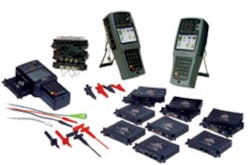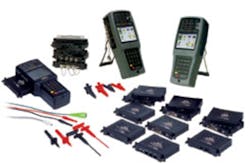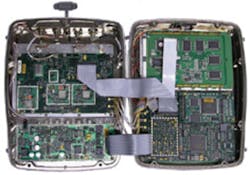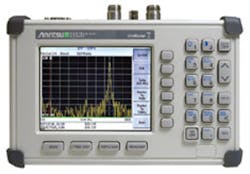Taking the Test Tools To the Application
Benchtop test instruments continue to set the performance standard against which portable equipment is judged. For example, how many hand-held digital multimeters provide eight-digit resolution and 0.001% accuracy? How many battery-powered
Courtesy of Sunrise Telecom
oscilloscopes have a 7-GHz bandwidth? None. However, the importance of traditional metrics is not obvious among several types of stand-alone communications test equipment.
Portable test tools are required for installing, commissioning, and troubleshooting copper-wired, fiber-optic cabled, and wireless networks. Because network performance depends on the installed topology and local sources of interference, the test equipment must be portable for use anywhere within the served area.
The type of test application dictates the required instrument features. For example, conventional benchtop test instruments are used in the design and development of wireless equipment. Compared to portable units, benchtop products may offer wider measurement ranges, higher accuracy, and more comprehensive capabilities.
As a specific example, a benchtop spectrum analyzer has higher accuracy, a lower noise floor, and a greater dynamic range than a portable unit. Detailed analysis capabilities for a specific service such as code division multiple access (CDMA) can be provided by adding optional software to a general-purpose spectrum analyzer. In contrast, a less accurate portable spectrum analyzer that recognizes a wide variety of wireless air interfaces might be more useful to a field technician.
Wired or fiber-optic cabled local area networks/wide area networks (LANs/WANs) also require portable test equipment, but some types of portable tools only loosely correspond to a conventional benchtop instrument. Hugo Draye, the copper marketing manager at Fluke Networks, explained, ??In the certification process for [copper] cabling, a hand-held tester like the Fluke DSP-4000 Series or the OMNIScanner2 delivers the accuracy to satisfy all test requirements with the exception of laboratory work.
??In the lab, people have adopted the network analyzer (NWA) as the standard tool to make accurate measurements over wide frequency ranges. These are complex [benchtop] instruments operated by skilled technicians,?? he continued. ??They require carefully crafted test-interface fixtures and are seldom used outside the laboratory.??
Where functionally suitable benchtop instruments do exist, the very limited space available in wiring closets and manholes and the harsh field environment may mitigate against their use. In addition, because a portable test tool is designed for use by an installer in the field, it often features one-button automated test capability and a simple and intuitive user interface. All these factors favor the portable instrument, especially if it provides nearly the same accuracy as the benchtop model.
Of course, there are optical and wireline instruments such as time-domain reflectometers (TDRs) available in both benchtop and portable formats. Even though the two instruments may have similar measurement capabilities, the requirements of the field application result in a different mix of features.
For example, the Fluke OptiFiber is an optical TDR (OTDR) that integrates loss/length certification, auto OTDR analysis, and end-face inspection. As proof that a fiber is properly installed and terminated, OptiFiber??s certification report documents the following:
- Length and dual wavelength insertion loss to comply with industry and customer standards.
- A visual ChannelMap?? diagram to quickly verify correct link configuration.
- Optical events and OTDR traces to identify and correct problems.
- High-resolution fiber end-face images to grade termination quality.
Because a bench-model OTDR is a general-purpose tool, it probably will not produce images of fiber end faces nor certification documentation to this level.
Finally, there are test applications such as navigation communications checkout for which a very complex set of requirements is satisfied by a dedicated test set. No other single test instrument comes close to covering the mix of signal generation, detection, and measurement that the test set performs. It must be portable because of the test environment, but there is no practical benchtop alternative.
Some ExamplesPortable vs. Benchtop Spectrum Analyzer
The specifications of the Anritsu Spectrum Master Model MS2711D Portable Spectrum Analyzer were compared with those of the company??s MS2683A benchtop model to see where each instrument excelled. Not surprisingly, some major differences besides size and weight existed.
Courtesy of Aeroflex
The benchtop unit is a general-purpose instrument. This means that you need to add special cellular measurement software if you require detailed analysis of CDMA or global system for mobile communications (GSM) signals. The basic model also provides several I/O ports such as intermediate frequency (IF) output, video output, sweep output, sweep state output, external reference frequency input, and trigger input. By connecting other instruments to these ports, an engineer can construct a complex test system.
In contrast, the portable MS2711D Spectrum Master is intended to be used by itself in the field to help a technician understand and solve communications systems problems. Detailed digital modulation analysis is not possible, but the unit does perform amplitude modulation, frequency modulation, and single sideband (AM/FM/SSB) demodulation and has the capability to identify common signal types by their bandwidth and spectrum skirt shape as an aid to determining the sources of interference.
However, the portable-benchtop line of demarcation is not clear-cut. Just as you can use an external reference frequency with the MS2683A, so you can with the MS2711D. Both instruments provide an external trigger input. And, the portable unit goes beyond the benchtop one by offering an optional transmission measurement feature. This capability supports scalar device characterization.
The distinction blurs more if you consider the MS2711D??s -135-dBm noise floor, +43-dBm maximum safe peak input level, built-in preamp, and memory for 200 sets of measurement data. The benchtop model has slightly better performance values of -137 dBm and +47 dBm peak. But the 20-dB preamp is an option, and you need a PC Card memory to store more than 12 sets of data.
In October 2003, the MS2711D introduced benefits from the latest technology; the benchtop MS2683A has been available for about two years. The good MS2711D performance means that application-specific requirements will drive portable vs. benchtop selection rather than glaring electrical performance differences.
Building a Better Navigation Test SetAnother type of comparison can be made between two portable navigation test sets that serve the same application. The NAV-402AP successfully addressed navigation communications ramp testing for more than 25 years. It has been replaced by the Model IFR4000 that weighs half as much, costs less, and offers greater functionality.
Competition in the market had increased to where other products offered more features than the NAV-402AP. The time had come to replace the instrument, but as Barry Beasley, head of avionics product development at the Wichita division of Aeroflex, said, ??We did not want to design a me-too product but instead wanted to leapfrog the competition. We achieved our goal by meeting several design requirements.??
Major improvements were needed in size, weight, battery duration, functionality, user interface, and price. Figure 1 shows the interior arrangement of PCBs and cabling within the machined aluminum case, which also serves as the cover for the radio frequency (RF) module. The single gasket provides EMC and environmental sealing that, together with water-tight connectors, makes the test set splash-proof.
A major consideration was ensuring a smooth transition for current NAV-402AP users to the new instrument. The combination of on-screen menus and dedicated and soft keys is different from the control and indicator scheme previously used, but logical layout and single-level menus help to make operation intuitive.
Addressing Multiple RequirementsAssume for the moment that a small, battery-powered, portable instrument is the best solution for many communications test applications. Because a single tool solves a specific type of problem, you may need many different tools. One solution offers a range of personality modules that customizes a generic instrument.
This is the approach taken by Sunrise Telecom in the SunSet MTT Modular Test Toolkit. Introduced in 1998, it was called the SunSet xDSL and had a modular architecture to cope with the many varieties of DSL at that time. Since then, T1/E/T3, Gigabit Ethernet, and fiber optic-test capabilities have been added. Today, more than 30 modules are available.
Customers benefit in several ways from the modular platform. The investment is somewhat guaranteed because modules can be added as technologies and network architectures change. The common interface improves user efficiency because most operations remain the same. Only training specifically related to the new application is required. Also, addressing multiple communication technologies with a single platform lowers the overall cost of ownership.
ConclusionYou will have chosen the right test equipment if it satisfies all the requirements of the application at a price within your budget. It remains true that benchtop test instruments generally out-perform portable test tools in terms of bandwidth, sampling rate, accuracy, and similar traditional metrics. It??s equally true that these capabilities may be secondary factors compared to size, ease of use, and provision of a comprehensive application-specific feature set.
Especially when installing, commissioning, and field troubleshooting, portable test tools require different features than lab-oriented benchtop instruments can provide. Instrument selection should start from a list of the application??s characteristics. Factors such as restricted access, for example, may cause test-tool size and weight to be ranked higher than traditional instrument performance metrics such as speed or accuracy.
Of course, you may not be giving up very much measurement performance at all, especially in the latest portable instruments. As Patrick Riley, senior product manager at Sunrise Telecom, commented, ??Modern field programmable gate arrays (FPGAs) and digital signal processors (DSPs) provide the power, functionality, and accuracy that might have required a benchtop instrument 10 years ago. For the majority of test functions, accuracy is not a function of size. Today, the only trade-off with hand-held instruments is the screen size.??
Communications Test Products Anritsu,
www.rsleads.com/401ee-179
Tektronix,
www.rsleads.com/401ee-182
Aeroflex,
www.rsleads.com/401ee-178
Fluke Networks,
www.rsleads.com/401ee-181
Ameritec,
www.rsleads.com/401ee-177
All contents ?? 2003 Nelson Publishing Inc.
No reprint, distribution, or reuse in any medium is permitted
without the express written consent of the publisher.




